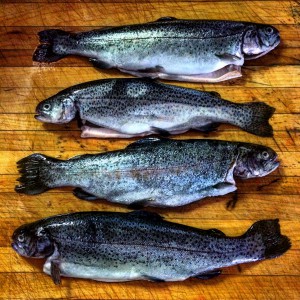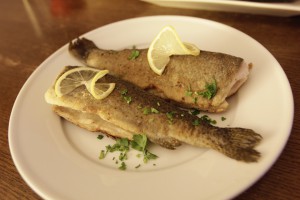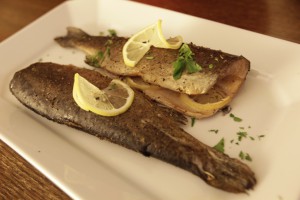
Rainbow Trout from Idaho.
In Boston, you often smell the ocean at least once a week, particularly when an east winds blow off the ocean toward the land. That brine-y, ocean-y smell makes me crave fresh seafood–and fortunately, there are two incredible fishmongers nearby. (Our local giganto-mart even offers quality, locally-caught fish among the imported options!)
While running a few grocery errands recently, something unusual caught my eye: wild rainbow trout from Idaho. Given the proximity of the ocean, you don’t typically see much freshwater fish for sale around here. Instantly, I was taken back to one of my favorite short stories, Hemingway’s Big Two-Hearted River. In great detail, Hemingway describes fly fishing for, catching, cleaning, and cooking trout for dinner. (I sometimes wonder if Hemingway missed his calling—he’d have been a great food writer, because along with this story’s trout dinner, there’s a description of bread with apple butter; and, in another Nick Adams story, one scene is devoted to a diner’s chicken croquettes.)

Make sure you soak the cedar plank in water before first.
Inspired by childhood memories of fishing with my Dad, and reminded of reading that Hemingway story, I figured trout was a no-brainer. They were fresh-looking, bright-eyed* and already dressed. My only remaining question: What method of cookery to apply? I posed the question to our social media fans. The feedback was split the difference: Cook two in the classic style (dredged in flour and pan-fried) and two in the Northwest style (grilled on cedar planks).
My techniques…
Clean the plank well after use, and you can easily reuse it a few times before it gives up the ghost.
Northwest style, cedar plank grilled. After obtaining your tasty and bright-eyed fish, pop those bad boys in the chill-box. Then grab your handy cedar planks, and soak them in water for at least an hour or two. (I like to soak mine in a half-sheet pan filled with water, and then weight them down with a brick I found on the sidewalk. Don’t worry: I cleaned the brick before I used it. You should, too.) So, come grill time, fire up your outdoor food furnace. Then, while waiting for your grill to come to temperature, remove the fresh fish from the fridge. Rinse and pat-dry, then liberally season inside and out with salt and pepper. (I shoved some lemon slices into the former fish-guts holding area, and also threw a tiny bit of chipotle chili with the salt ‘n peppa, but that’s me. You do you.)
Keep it simple and let the delicate flavors come through.
After seasoning, pop the fish between two planks, and then place the planks-and-fish onto the grill for about 10 minutes. While your fish ‘n plank is cooking, drain most of the water from the half-sheet you’d soaked the planks in, and have it standing by the grill. By the time the 10 minutes is up, the cedar plank will have smoked for a few minutes, giving your fish a bit of smoke, but not too much. After 10 minutes, carefully lift the plank off the grill, place it back onto the half sheet pan used for soaking. That little trick kills the embers and gives the fish a bit of extra smoke by way of a steam bath.
My sides of choice were grilled veg (asparagus) and rice pilaf. My outdoor food furnace is a gas number with a side burner, so I threw together some rice pilaf while waiting on the fish. If you’re working a classic Weber kettle (or other charcoal grill) maybe keep that rice prep indoors for the sake of easier prep.
Cooking fish in bacon fat will work, but it will overpower it.
Classic Pan-Fried Trout. In your favorite heavy-bottomed cast iron skillet or heavy cladded sauté pan, preheat equal parts butter and vegetable oil. (Bacon fat? Yes. You can use bacon fat. But your fish will taste like bacon. That’s not a bad thing, but that’s a totally different recipe.) Where were we? Okay, remove your fresh fish from the fridge, and as with the Northwest method, rinse it and pat it dry. However, this time, dry the living daylights out of it. I mean, dry that fish. (Here’s an easy-to-remember cooking mantra: Gonna fry it? Really dry it!) As with the Northwest method, liberally season the fish with salt and pepper (or whatever…you do you). Then, dredge the fish thoroughly on both sides with flour. Gently place the whole fish in the hot (about 375 degrees) oil, and cook for five minutes per side. Remove the happily fried, golden brown fish and place onto whatever serving thingey you have. I toss on some thinly sliced lemons and chopped parsley for flair.

Expecting to see something breaded looking because we used flour, right? Nope. That’s another recipe.
The taste-test winner: It depends! If it’s summertime and you have access to an external food furnace, go for the cedar-planked version. It’s ridiculously easy, there’s almost no mess to clean up on the grill itself, and the plank will protect the fish from the fire. Just make sure you are good with the smoked cedar flavor the fish will take on.
As for the pan-fry, if you do not have good stove top ventilation, your dwelling may smell faintly fish-tastic for a while, but if you can open a few windows and don’t mind a bit of fry-oil odor, I say go for it. You’ll end up with crispy-skinned, moist, old-school style fish. And keep in mind, this pan technique works well for most other thin, whole fish or nearly any fish fillets.



